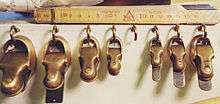Finger plane

A finger plane is a small plane, usually with a brass body, typically used by luthiers: violin and guitar makers.
Finger planes are used for final trimming work after glue-up, particularly around curved edges and to level inlays across curved instrument tops. They are thus small in length, as they do not need to span a wide area as a jointer plane does. They are also narrow in blade width, as they are meant for trimming the edges of thin boards, or for scrubbing small areas when graduating the thickness of arched soundboards. Some have flat bases, for convex work; the more distinctive have curved bases for concave surfaces. They are made with soles in a range of curvatures and a typical workshop will have several, of varying curvature.

As the planes are only used for a narrow task, they are not adjustable and they are made with fixed mouths and a blade that is clamped in place by a simple wedge,[1] or by a clamp screw, not an adjuster. To add mass to such a small plane, they are commonly cast in a dense brass or bronze alloy. Luthiers making their own planes typically make them from offcuts of dense tropical hardwoods. Ibex is a widely known manufacturer of bronze planes.[2][3]
References
- ↑ "Herdim® Plane With Wooden Wedge".
- ↑ "Improved chip clearance for a finger plane". Hamlett Instruments.
A lot of builders of carved arch top instruments, like mandolins and archtop guitars, use these little Ibex finger plane
External link in|publisher=(help) - ↑ "Ibex Violin Makers Planes".
Ibex violin makers planes have been somewhat of a standard for modern luthiers.